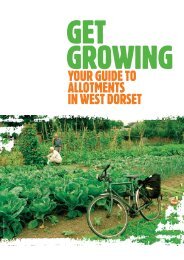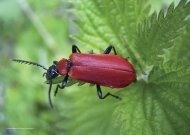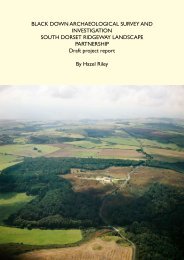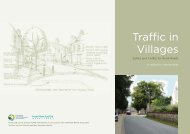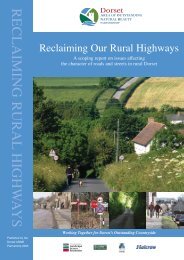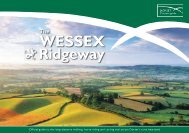Woodland Strategy 11.34 Mb - the Dorset AONB
Woodland Strategy 11.34 Mb - the Dorset AONB
Woodland Strategy 11.34 Mb - the Dorset AONB
You also want an ePaper? Increase the reach of your titles
YUMPU automatically turns print PDFs into web optimized ePapers that Google loves.
Section 7<br />
woodland needs to be monitored.<br />
Rhododendron ponticum is a plant that is extremely invasive and dominates woodland to<br />
<strong>the</strong> detriment of many o<strong>the</strong>r woodland species, particularly floral species. Without<br />
appropriate management <strong>the</strong> continued increase of invasive non-native species will impose<br />
long term changes to <strong>the</strong> composition and thus <strong>the</strong> biodiversity and economics of <strong>Dorset</strong>’s<br />
woodlands.<br />
In order to reduce <strong>the</strong> impact of <strong>the</strong>se and o<strong>the</strong>r invasive species a co-ordinated, cohesive<br />
approach needs to be adopted as well as ensuring that appropriate resources are in place<br />
to facilitate this important aspect of woodland management.<br />
Non-Wooded (open) Habitats<br />
Heathlands, fens and native grasslands are important open habitat communities and all have<br />
Habitat Action Plans relating to <strong>the</strong>m. These habitats have been lost to agriculture, forestry,<br />
mineral extraction and development. In <strong>Dorset</strong> <strong>the</strong> planting of conifers on heathlands had<br />
led to a significant loss of this habitat type in <strong>the</strong> county although corridors and fragments<br />
survived within <strong>the</strong> plantations. Today planting of conifers on heathlands and grasslands has<br />
stopped and much work has been undertaken to restore sites to <strong>the</strong>ir former habitat type.<br />
However, without a concerted, pro-active effort to manage <strong>the</strong>se habitats <strong>the</strong>y will continue<br />
to be lost to <strong>the</strong> natural regeneration of trees and scrub..<br />
Within <strong>the</strong> ‘heathland’ areas of East <strong>Dorset</strong> and Purbeck <strong>the</strong>re are a number of ancient<br />
woodland sites. These are extremely important, and very diverse, woodlands. They tend<br />
to be situated where <strong>the</strong>re is a change in <strong>the</strong> underlying soils and geology, usually on <strong>the</strong><br />
boundaries of <strong>the</strong> sandy soils of <strong>the</strong> heaths and <strong>the</strong> chalk soils of <strong>the</strong> valley slopes. For this<br />
reason <strong>the</strong>y are extremely biodiverse as <strong>the</strong>y support species and populations associated with<br />
both types of soils and geology.<br />
Forestry plantations also play an important part in supporting <strong>the</strong> flora and fauna associated<br />
with heathlands and grasslands. The term ‘forest’ describes <strong>the</strong> old hunting forests of <strong>the</strong><br />
past, which were made up of woodlands with large open heath and grassland areas, such as<br />
<strong>the</strong> New Forest. Today’s forestry can, to a degree, re-create this mosaic of habitats through<br />
restructuring <strong>the</strong> forest by clear-felling and thinning. This provides a diversity of age<br />
structure and habitats within a large area, thus supporting a rich and varied population<br />
of flora and fauna species.<br />
The restoration and management of non-wooded habitats does not necessitate <strong>the</strong> complete<br />
removal of trees. When considering <strong>the</strong> re-creation of non-wooded habitats, consideration<br />
needs to be given to <strong>the</strong> habitat type and whe<strong>the</strong>r <strong>the</strong> retention of woodland or forest is<br />
appropriate for biodiversity or landscape reasons. They provide a diversity of habitat,<br />
species and structure, as well as replicating <strong>the</strong> successional stages that open habitats would<br />
undergo through natural processes. These woodlands are particularly important to flora<br />
and insect species and <strong>the</strong> species that depend on <strong>the</strong>m, such as nightjars (Caprimulgus<br />
europaeus) which use <strong>the</strong> woodland and forest edges to forage.<br />
Fragmentation<br />
Until quite recently new woodland plantings haven’t been managed strategically, this has led<br />
to a fragmented woodland landscape made up of many small individual woodlands<br />
Habitat fragmentation at a variety of scales has been widely linked with <strong>the</strong> decline of many<br />
species globally. Over recent decades <strong>the</strong>re has been a recorded decline in <strong>the</strong> biodiversity of<br />
many semi-natural woodlands and open habitats despite protection through designations<br />
such as Sites of Special Scientific Interest and National Nature Reserves. The long-term<br />
viability of woodland biodiversity, which evolved within a highly connected and extensive<br />
habitat, is threatened by fragmentation of habitats and landuse, as it leads to smaller and<br />
more isolated woodlands.<br />
Fragmentation or isolation of veteran trees is also an issue as micro habitats and associated<br />
species have little chance of colonising elsewhere. The number of truly ancient trees in<br />
<strong>Dorset</strong> is quite small (Cooch, pers.comm.) and those old veterans that will become <strong>the</strong> new<br />
ancient trees are often badly managed, cut down or blow over. More tree planting and<br />
identification of future veteran and ancient trees needs to be undertaken.<br />
Ecologists advocate <strong>the</strong> maintenance and improvement of connectivity between fragmented<br />
woodland populations, with growing interest in <strong>the</strong> use of habitat networks to reverse <strong>the</strong><br />
effects of fragmentation by expanding and linking isolated habitats. Britain's woodland,<br />
which may have once covered up to 75% of <strong>the</strong> land area, has been fragmented to such a<br />
degree that less than 5% remained by <strong>the</strong> beginning of <strong>the</strong> 19th Century. Afforestation<br />
throughout <strong>the</strong> 20th Century has increased woodland cover, however <strong>the</strong> ancient seminatural<br />
remnant woodlands remain largely fragmented: new plantations provide<br />
unfavourable habitat for characteristic woodland specialists, and are spatially unconstrained<br />
while <strong>the</strong> surrounding matrix is often intensively managed, remaining unsuitable for<br />
woodland species dispersal.<br />
Species conservation through habitat networks has developed rapidly since <strong>the</strong> signing<br />
of <strong>the</strong> Convention on Biological Diversity 1992. This has prompted some international<br />
acceptance and emerging agreement of <strong>the</strong> need to conserve biological diversity using<br />
an approach which includes <strong>the</strong> planning, establishment and adaptive management of<br />
protected-area networks (Forestry Commission Information Note 073)<br />
53



